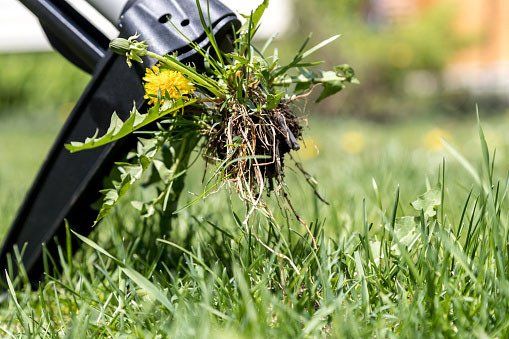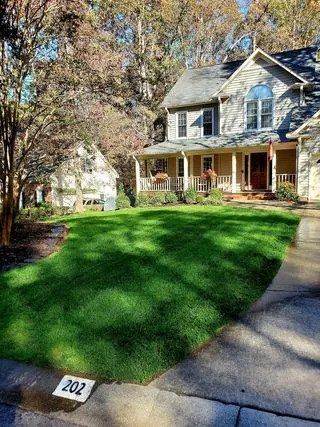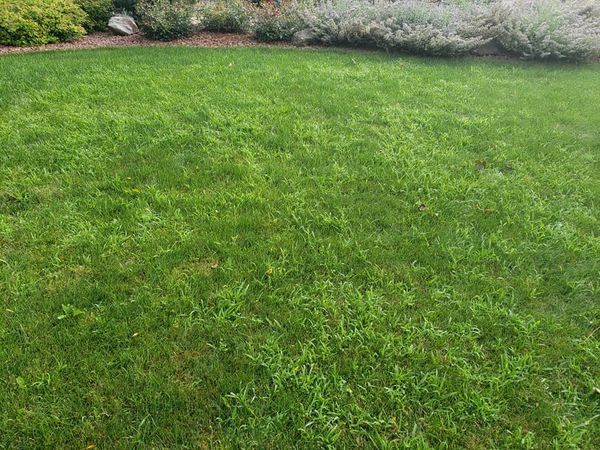WEED CONTROL IN SANFORD NC
Looking for a weed killer company near me in Sanford NC?
Green Garden Landscape offers affordable weed control services for all types of weeds while keeping your all your beloved grass healthy.
landscaping Services
Get A Quote
Contact Us
We will get back to you as soon as possible
Please try again later

Professional Weed Control Services In Sanford, NC
Green Garden Landscaping, the best weed killer company in Sanford, uses top quality weed control products, and its skillful technicians ensure you the thorough weed spraying of your lawn to ensure that no weed will be growing on Spring or Fall. Green Garden Landscaping promises you thicker and tougher grass and greener lawn view.
Upon distinguishing the type of weed growing at your lawn, we will choose the best weed killer products to keep them away from your lawn.
With our more than 15 years of experience on weed control services in Sanford, we have the enough knowledge and experience to effectively rip out those invasive plants growing behind with your healthy and lovely grass. Killing them is easier with an expert!
To know more about techniques and weed control products, contact us by filling up the the contact form.
We pride ourselves on offering affordable full-service weed control services for local home and business owners in Sanford, NC
Weeds: The Thief of your Lawn Beauty in North Carolina
Since everything is running in the race of survival of the fittest, your lawn is no exception. Not every plant is desirable, especially in your mini garden.
Weeds are those undesirable plants in your garden which compete with the other plants for water, nutrients, sunshine, and space. Weeds are pretty resilient, grow in no time and take over the whole lawn very quickly. Without proper lawn maintenance, weeds will be growing much more than your grass.
In the pursuit of taking over the yard, they could be harmful to the ornamental plant which you grew with extensive efforts. Hence, you need to have a strict check on the lawn and discourage their presence in your lawn. To apply the right strategy of weed control, you need to identify the type of weeds.
Expert and Affordable Weed Control Near You
Green Garden's Weed Control Service is your solution to achieving a pristine and weed-free outdoor space.
We understand the persistent challenges that weeds pose in gardens and lawns. Our dedicated team of experts utilizes proven strategies and eco-friendly methods to keep these unwanted intruders at bay.
With a tailored approach, we address the specific weed species that affect your landscape, ensuring they are effectively controlled.
Whether it's through pre-emergent treatments to prevent weed growth or post-emergent solutions for existing weeds, our service is designed to maintain the beauty and health of your garden or lawn.
Green Garden's Weed Control Service not only transforms your outdoor space into a neat and visually appealing paradise but also contributes to the long-term well-being of your plants, grass, and overall landscape.
With us, you can savor a weed-free environment that thrives throughout the seasons.
Pre-emergent Service for Weed Control
It is a method of weed control in which you apply herbicides and treat your lawn before the germination of any weed. Since different weeds grow at different temperatures and times of the year, it is crucial to apply herbicides timely if you are going to opt for a pre-emergent weed control method. It could be disastrous if you do not use herbicides in the correct ratio, and this
unbalanced chemical application could result in killing or stunt the growth of your desired vegetations. Green Garden Landscaping well educated and trained staff knows the best practices in pre-emergent weed control and ensures the health and safety of your lawn vegetations.
- Pre-Emergent
The easiest way of weed control
Pre-emergent is the easiest way of weed control since you stop weeds sprouting at the very first place. It will save you from the effort of plucking them before treating the soil for the future.
- Post-Emergent
Post-emergent weed control
Post-emergent management is applied when weeds already have invaded your lawn. It is because you skipped pre-emergent weed treatment. Moreover, sometimes a few weeds survive pre-emergent herbicide treatment miraculously.
So, post-emergent herbicide control comes to play in this scenario. These chemicals kill the existing weeds by affecting their roots. Green Garden Landscaping make sure the herbicides only affect the weeds, and the desired vegetations continue to flourish and thrive.
- Weed Control
Broader protection against weeds
As post-emergent herbicides also kill those weeds which survive the pre-emergent herbicides, this method provides broader coverage to weed management.
Seasonal Lawn Care Maintenance
As we know weed control is just a part of your lawn maintenance for the whole year.
To keep your lawn and grass healthy, you need to do fertilization, lawn mowing and other lawn maintenance. We provide seasonal lawn maintenance packages to help you keep your grass looking great in Fall, Spring, Winter or Summer. Contact us to get more details.
- Eco-Friendly Practices: Green Garden prioritizes eco-conscious methods in our weed control efforts. We use environmentally organic products and techniques to minimize the impact on the surrounding ecosystem, safeguarding the health of humans and pets, while contributing to a more sustainable environment.
Weed Control Frequently Asked Questions
If you need more information regarding weed control, we compile these frequently asked questions to help you.
-
How can we control weed?
To stop these weeds from destroying your lawn beauty, you can control them using the following methods:
1) Cultural practices to control weeds: It involves practices that promote healthy turfgrass and discourage weed growth. It includes land preparation, variety selection, regular watering and fertilization, mowing, etc.
2) Mechanical methods of weed control: Most perennial weeds are stubborn and survive the cultivation weed control methods.
So mechanically removing those weeds, such as hand pulling or removing weeds mechanically using specialized equipment, ensures a weed-free lawn.
3) Chemical methods of weed control: Mechanical method may be an effective weed control method for the time being and does not ensure the reemergence of weeds.
However, the chemical method involves the use of herbicides, including pre-emergent herbicides, post-emergent herbicides, selective and nonselective herbicides, etc, that keep your lawn weed-free throughout the season.
To know more on how to control weed contact a weed control experts like Green Garden Landscaping to help you control weed in you lawn.
-
What are the types of weed?
Generally, the lawn weeds are categorized into three major groups depending on their life cycle.
It includes perennial weeds, biennial weeds, and annual weeds.
Depending on the leaf size, weeds are further divided into broad leaves, sedges, and grasses.
Grasses: Grass seedlings are monocotyledons that have only one seed leaf. Generally, their leaves are long and narrow, having parallel veins.
This group includes crabgrass and dayflower. Sedges: Usually, stems of sedges are solid and triangular. They have a three-ranked leaf arrangement. There are no distinct sheath-blade divisions, and the basal portion of each leaf is fused to form a tube-like structure around the stem. Each leaf arises one-third of the way around the stem from the leaf below. Sedges can reach up to 4 feet in height. Purple Nut Sedge and Watergrass are examples of sedges.
Broadleaved weeds: This group has expanded leaf blades. Venation of the leaves may be parallel as in monocots or netted as in dicots.
Mainly, the common lawn weeds belong to this group. Plantain, Purslane, and Smartweed are some of the examples of broadleaved weeds.
Perennial weeds: These weeds reproduce from seeds and vegetative parts of the plant, such as below-ground root-like stems, including rhizomes, creeping roots, tubers, and bulbs, or above-ground stems that produce roots such as stolons. These weeds are able to survive for more than two years. Examples are pokeweed, Poison Ivy, Black Medic, etc.
Biennial weeds: These weeds live for more than one year but are unable to survive for more than two years. Examples are Musk Thistle, Yellow Salsify, etc.
Annual weeds: These weeds survive for one year or less. Most varieties reproduce by seeds only. However, some varieties also reproduce by adventitious roots on prostrate stems. This means they may root and form new plants if their stems are damaged or cut.
The most common garden weeds are annuals. Examples are knotweed, crabgrass, Purslane, etc. In this different variety of weed type, you can use a Blanket Weed Controller to easily stop this weed on growing.
-
When should pre-emergent weed control be applied?
The key to a flourishing lawn and garden is planning.
So knowing ahead when to fertilize, when to use weed killers, and how much water your lawn needs ensure a lush green and healthy lawn.
Pre-emergent weed killers are types of herbicides that don't kill weeds and unwanted plants. Instead, they stop the weeds' seeds from sprouting in the first place. Various pre-emergent herbicides are available for lawns, flower beds, and vegetable gardens.
However, if you apply them too early, it may hinder the sprouting of beneficial seeds.
On the contrary, if you apply pre-emergent weed killers too late, it won't do any good.
Therefore early spring and fall are considered the most effective times of the year to apply pre-emergent weed killers.
Early spring pre-emergent weed killer application drastically reduces the emergence of annual summer weeds, which germinate in late spring. This includes crabgrass, sandbur, and foxtail.
On the other hand, henbit and chickweed wait for cooler temperatures before sprouting; therefore, fall application of pre-emergent herbicides will do the trick.
Hiring a weed control expert can help you do that job easily, contact Green Garden Landscaping today!.
-
Is pre-emergent weed killer safe?
Most pre-emergent herbicide products are safe for humans and pets when used as directed.
In many independent toxicity studies, pre-emergent herbicides have proven remarkably safe for homeowners, children, and pets.
To maximize safety, you need to plan ahead.
The best time to apply is when children and pets are not around.
To prevent this happening from your family, hire a lawn care company immediately and destroy this weed permanently.
Green Garden Landscaping can help you, call us at (919) 478-1852.
-
When can I apply weed and feed after pre-emergent?
If you are planning to apply pre-emergent weed and feed, then the best application time is before the germination of weed seed.
To control summer weeds, the best time to apply weed and feed is in the early spring.
However, you should apply weed and feed in mid-April if you are trying to kill crabgrass. Wait at least one week after applying pre-emergent weed before fertilizing your lawn.
On the other hand, applying weed & feed during the winter season will have no effect at all on the lawn in the following seasons: spring and summer. Moreover, don't apply weed and feed more than twice per year and wait for at least two months before reapplying the product.
To know when and how to apply pre-emergent products, hiring a lawn care company can help you, contact us at (919) 478-1852 .
-
How long does it take for a post-emergent weed killer to work?
Post-emergent weed killers are some of the most popular chemicals for weed control.
The post-emergent herbicide kills the weeds that have already sprouted from the ground and invaded the turfgrass.
On the contrary, a pre-emergent herbicide kills the weeds before they sprout. Once the soil temperature reaches about 55, most weeds start to germinate.
That means a post-emergent herbicide will be your choice to control weeds from spring through fall.
However, post-emergent herbicides will have no effect unless weeds are actively growing.
Usually, a post-emergent weed killer takes between five to seven days to produce noticeable results.
You need to wait up to 21 days for weeds to completely disappear from your lawn.
Applying weed and feed at proper times is the key to maximum weed control.
-
How does post-emergent weed killer work?
Post-emergent weed killers are chemicals that control weeds after the weeds have germinated. They kill weeds by traveling down the plant stem to the root system.
Here these herbicides destroy the roots and deprive the plant of essential nutrients and water. Weeds do not survive long without water and nutrients and die within no time.
So to achieve maximum control with post-emergent herbicides, it should be applied when weeds are actively growing.
Post-emergent herbicides are divided into systemic or contact application formulas. Systemic formulas work best to kill perennial weeds. These chemicals are absorbed directly by the plant and move throughout the plant system for maximum killing action.
On the other hand, contact herbicides are used on smaller annual weeds to kill the exposed parts. Contact post-emergent herbicides may seem to be less significant than systemic post-emergent herbicides as they only kill the foliage.
However, the death of the exposed parts, such as leaves, is enough to kill the entire plant.
Post-emergent herbicides are also classified as selective herbicides and nonselective herbicides. Selective herbicides only kill certain weeds and are used in lawn areas where contact with the grass is unavoidable.
In comparison, nonselective herbicides are used for killing weeds on a larger scale. They kill both grassy and broadleaf weeds.
To get this job done, hire Green Garden Landscaping today!
Best Landscaping, Lawn Service And Hardscaping Company in North Carolina
Our Landscape Maintenance Guarantee! A Personal 100% Iron-Clad, Risk Free, Double Money Back Guarantee. Certified by the NC Landscape Contractors Licensing Board.
100%
SATISFACTION GUARANTEE
Professional Residential and commercial Landscaping, Lawn Care, and Hardscaping Solutions for Communities in Sanford, Cameron, Aberdeen, and the Greater North Carolina Area.
Our SERVICES
Our company
Green Garden Landscaping | All Rights Reserved · Web site Design By PeakReack Marketing Solution




